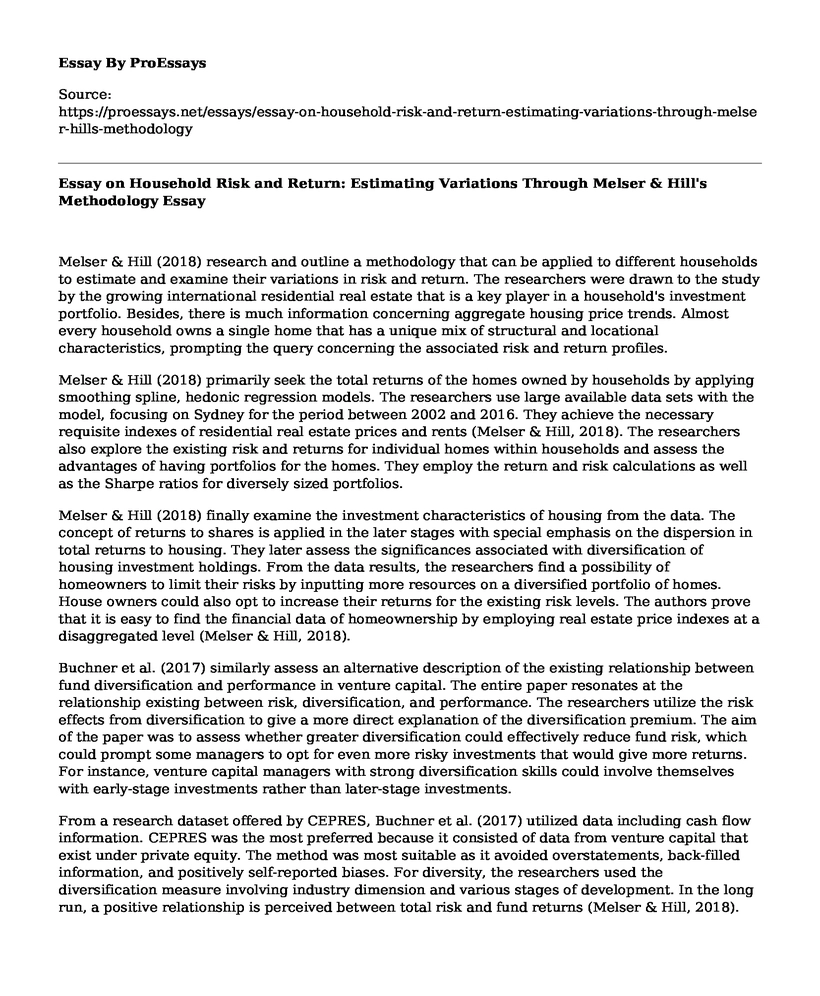Melser & Hill (2018) research and outline a methodology that can be applied to different households to estimate and examine their variations in risk and return. The researchers were drawn to the study by the growing international residential real estate that is a key player in a household's investment portfolio. Besides, there is much information concerning aggregate housing price trends. Almost every household owns a single home that has a unique mix of structural and locational characteristics, prompting the query concerning the associated risk and return profiles.
Melser & Hill (2018) primarily seek the total returns of the homes owned by households by applying smoothing spline, hedonic regression models. The researchers use large available data sets with the model, focusing on Sydney for the period between 2002 and 2016. They achieve the necessary requisite indexes of residential real estate prices and rents (Melser & Hill, 2018). The researchers also explore the existing risk and returns for individual homes within households and assess the advantages of having portfolios for the homes. They employ the return and risk calculations as well as the Sharpe ratios for diversely sized portfolios.
Melser & Hill (2018) finally examine the investment characteristics of housing from the data. The concept of returns to shares is applied in the later stages with special emphasis on the dispersion in total returns to housing. They later assess the significances associated with diversification of housing investment holdings. From the data results, the researchers find a possibility of homeowners to limit their risks by inputting more resources on a diversified portfolio of homes. House owners could also opt to increase their returns for the existing risk levels. The authors prove that it is easy to find the financial data of homeownership by employing real estate price indexes at a disaggregated level (Melser & Hill, 2018).
Buchner et al. (2017) similarly assess an alternative description of the existing relationship between fund diversification and performance in venture capital. The entire paper resonates at the relationship existing between risk, diversification, and performance. The researchers utilize the risk effects from diversification to give a more direct explanation of the diversification premium. The aim of the paper was to assess whether greater diversification could effectively reduce fund risk, which could prompt some managers to opt for even more risky investments that would give more returns. For instance, venture capital managers with strong diversification skills could involve themselves with early-stage investments rather than later-stage investments.
From a research dataset offered by CEPRES, Buchner et al. (2017) utilized data including cash flow information. CEPRES was the most preferred because it consisted of data from venture capital that exist under private equity. The method was most suitable as it avoided overstatements, back-filled information, and positively self-reported biases. For diversity, the researchers used the diversification measure involving industry dimension and various stages of development. In the long run, a positive relationship is perceived between total risk and fund returns (Melser & Hill, 2018).
Melser & Hill (2018) as well as Buchner et al. (2017) arrive at various findings. For instance, it is noted that venture capital firms would have higher returns as a result of diversification as there would be a premium on average. However, only the well-experienced venture capital managers can access greater and risky investments that would anyway lead to greater returns. Additionally, it is the large pool of investments that would let the managers realize a better mix of risk and return (Melser & Hill, 2018). The achievement of greater returns after engaging with risks also calls for endogeneity (Buchner et al., 2017). It is the phenomenon that supports the Risk Hypothesis by Buchner and his accomplices.
References
Buchner, A., Mohamed, A., & Schwienbacher, A. (2017). Diversification, risk, and returns in venture capital. Journal of Business Venturing, 32(5), 519-535. doi:10.1016/j.jbusvent.2017.05.005
Melser, D., & Hill, R. J. (2018). Residential Real Estate, Risk, Return and Diversification: Some Empirical Evidence. The Journal of Real Estate Finance and Economics. doi:10.1007/s11146-018-9668-x
Cite this page
Essay on Household Risk and Return: Estimating Variations Through Melser & Hill's Methodology. (2023, Apr 24). Retrieved from https://proessays.net/essays/essay-on-household-risk-and-return-estimating-variations-through-melser-hills-methodology
If you are the original author of this essay and no longer wish to have it published on the ProEssays website, please click below to request its removal:
- Risk Management in IT Infrastructure: COBIT v4.1 Framework
- Preventing Scandal through Ethical Leadership: Annotated Bibliography
- Mother's Choice Bakers New Branch Essay
- Global Business Issues in Decision Making Essay Example
- Coach Bob's Coaching Philosophy and Style Paper Example
- Essay Example on Robust IT Systems: A Necessity for Business Entities
- Essay Example on Women's Leadership in Church: Bible vs Culture







